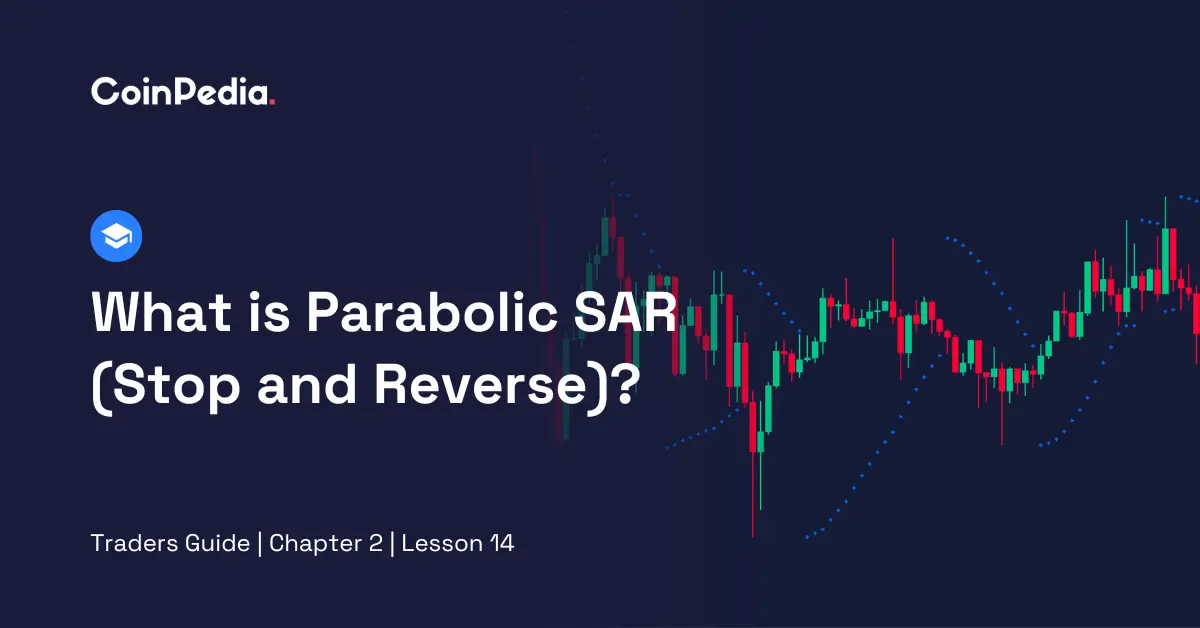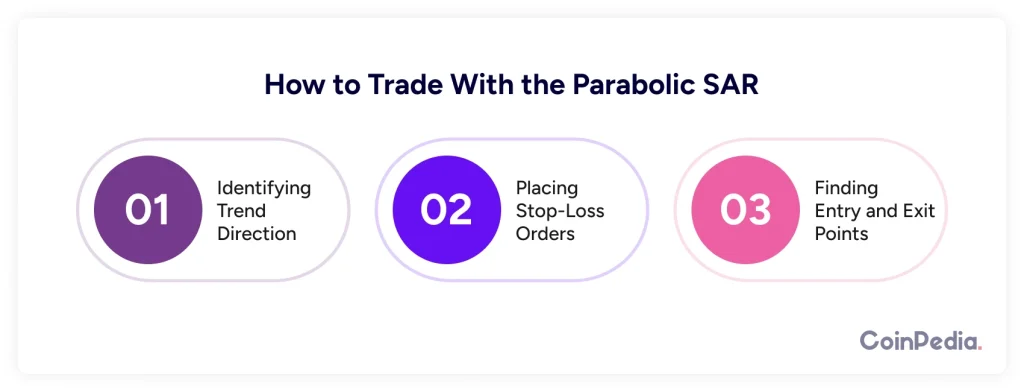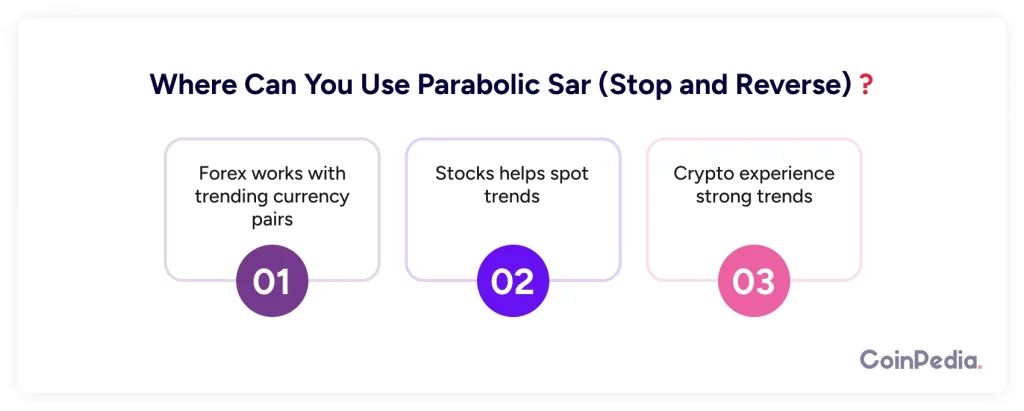
Have you ever looked at a chart and thought, How do these traders spot trends before everyone else? If you’ve been in the trading world for a while, you’ve probably heard about different indicators—moving averages, RSI, MACD. But one indicator that often gets overlooked is the Parabolic SAR (Stop and Reverse).
It’s not just another squiggly line on a chart. It’s a powerful tool that helps traders identify trend direction and even provides entry and exit signals. Sounds useful, right? Let’s break it down in a simple, easy-to-understand way so you can start using it like a pro.
What Is Parabolic SAR (Stop and Reverse)?
First things first, what exactly is the Parabolic SAR?
Developed by J. Welles Wilder Jr., the same guy who created the Relative Strength Index (RSI), the Parabolic SAR is a trend-following indicator. It helps traders determine the direction of a trend and signals potential reversals.
It appears on a chart as a series of dots—either above or below the price.
- When the dots are below the price, it suggests an uptrend.
- When the dots are above the price, it signals a downtrend.
- When the dots switch positions, it may indicate a trend reversal.
Why the Name “Parabolic SAR”?
The word Parabolic comes from how the dots curve as the trend continues—almost like the arc of a parabola. And SAR stands for Stop and Reverse, meaning once the trend shifts, the indicator flips sides.
Simple enough, right? Now let’s get to the good part—how to actually use it in your trades.
How to Trade With the Parabolic SAR?
1. Identifying Trend Direction
The Parabolic SAR is best used in strong trending markets. If the dots are below the price, it means buyers are in control. If they’re above, sellers are dominating.
Example: Let’s say you’re looking at Bitcoin’s price chart. If the dots are forming below the candles and are rising along with the price, it means Bitcoin is in an uptrend. But the moment these dots shift to above the price, it could indicate a reversal.
2. Placing Stop-Loss Orders
One of the best uses of the Parabolic SAR is setting stop-losses. Since the dots represent potential reversal points, traders often use them as a trailing stop-loss. This means that as the trend continues, you can adjust your stop-loss to the latest SAR dot.
Example: Imagine you’re long on Ethereum at $2,000. The SAR dots are forming below the price. As the price moves up to $2,200, the SAR moves up too. You could place your stop-loss just below the SAR dot, locking in profits while allowing the trade to run.
3. Finding Entry and Exit Points
- Buy when the SAR flips below the price.
- Sell when the SAR flips above the price.
Example: If Tesla stock has been in a downtrend and suddenly the SAR dots flip below the price, it might be a buy signal.
But be careful—it’s not foolproof. That’s why many traders combine it with other indicators.

Indicators to Use With the Parabolic SAR
While the Parabolic SAR is powerful, it works best when paired with other indicators for confirmation.
1. Moving Averages (MA)
If the Parabolic SAR signals an uptrend but the price is below the 200-day moving average, the trend might not be strong. Combining SAR with MAs helps avoid false signals.
2. Relative Strength Index (RSI)
RSI tells you if an asset is overbought or oversold. If the SAR suggests a buy, but RSI is above 70 (overbought zone), the price might soon reverse.
3. MACD (Moving Average Convergence Divergence)
MACD helps confirm momentum. If the SAR flips bullish, and MACD also shows an upward crossover, it’s a stronger confirmation.
Is Parabolic SAR Reliable?
Now, let’s be real—no indicator is perfect. Parabolic SAR works best in trending markets but fails in sideways (choppy) markets.
When It Works Well:
- Strong uptrends or downtrends
- Volatile assets like crypto or tech stocks
- Trending forex pairs
When It Fails:
- Consolidation phases
- Ranging markets (price moving sideways)
- Fake breakouts
That’s why traders always combine SAR with other indicators.
Also Read: Aroon Indicator: A Must-Read for Beginners in Crypto Trading
Markets and the Parabolic SAR
Where can you use this indicator? Pretty much any market with trends!
- Forex: Works well with trending currency pairs like EUR/USD.
- Stocks: Helps spot trends in Tesla (TSLA), Apple (AAPL), etc.
- Crypto: Since Bitcoin and altcoins experience strong trends, SAR is useful for riding price waves.
Example: If you’re trading gold (XAU/USD) and the dots start rising, it could be a good sell signal.

Understanding the Parabolic SAR in Action
Let’s say you’re a crypto trader. You’re looking at Bitcoin and notice the SAR dots are below the price at $40,000. The price continues climbing. Suddenly, the dots switch to above at $46,000.
- Your move? Maybe take profits because a reversal could be near.
- What if MACD also shows a bearish crossover? Stronger confirmation to sell.
- What if RSI is still low (below 50)? Maybe the uptrend still has room to run.
This is how you think like a trader—using multiple tools together.
Final Thoughts: Should You Use Parabolic SAR?
Absolutely! But not alone. It’s great for:
- Identifying trends
- Placing stop-loss orders
- Finding reversals
But remember, it struggles in sideways markets. That’s why smart traders combine it with other indicators like moving averages, RSI, and MACD.
So next time you’re analyzing a chart, don’t ignore those little dots—they might just help you catch the next big move!
FAQs
Yes, the Parabolic SAR can be used for scalping or short-term trading, but it’s more effective on higher time frames. On lower time frames (like 1-minute or 5-minute charts), the indicator may give too many false signals due to market noise. Combining it with a faster-moving indicator, like the EMA (Exponential Moving Average), can improve its accuracy for scalping.
The core principle of the Parabolic SAR remains the same across different markets—it identifies trends and potential reversals. However, since stocks can be more affected by fundamental events (like earnings reports), traders should use SAR alongside fundamental analysis to make informed decisions.
Yes! The default settings for the Parabolic SAR (Acceleration Factor = 0.02, Maximum Step = 0.2) can be adjusted. Increasing the Acceleration Factor makes the SAR more sensitive, leading to faster signals but more potential false alarms. Lowering it makes SAR less responsive but more reliable for long trends. Adjusting these values based on the asset’s volatility can improve accuracy.
To avoid false signals, traders should combine SAR with other indicators like the Moving Average, RSI, or MACD. Additionally, it’s important to trade in trending markets rather than ranging (sideways) markets, where SAR tends to produce unreliable signals.
Yes! Many trading bots and automated strategies use the Parabolic SAR as part of their algorithm. Since it provides clear entry and exit signals, it’s relatively easy to integrate into automated trading systems. However, it should be used in combination with other filters to improve accuracy.
We'd Love to Hear Your Thoughts on This Article!
Was this writing helpful?
 Yes
Yes  No
No
Trust with CoinPedia:
CoinPedia has been delivering accurate and timely cryptocurrency and blockchain updates since 2017. All content is created by our expert panel of analysts and journalists, following strict Editorial Guidelines based on E-E-A-T (Experience, Expertise, Authoritativeness, Trustworthiness). Every article is fact-checked against reputable sources to ensure accuracy, transparency, and reliability. Our review policy guarantees unbiased evaluations when recommending exchanges, platforms, or tools. We strive to provide timely updates about everything crypto & blockchain, right from startups to industry majors.
Investment Disclaimer:
All opinions and insights shared represent the author's own views on current market conditions. Please do your own research before making investment decisions. Neither the writer nor the publication assumes responsibility for your financial choices.
Sponsored and Advertisements:
Sponsored content and affiliate links may appear on our site. Advertisements are marked clearly, and our editorial content remains entirely independent from our ad partners.




